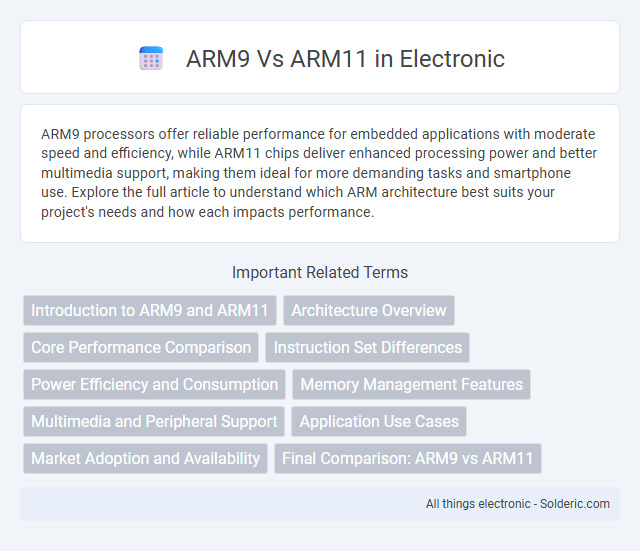ARM9 processors offer reliable performance for embedded applications with moderate speed and efficiency, while ARM11 chips deliver enhanced processing power and better multimedia support, making them ideal for more demanding tasks and smartphone use. Explore the full article to understand which ARM architecture best suits your project's needs and how each impacts performance.
Comparison Table
| Feature | ARM9 | ARM11 |
|---|---|---|
| Architecture | ARMv4T / ARMv5TE | ARMv6 |
| Clock Speed | Up to 400 MHz | Up to 1 GHz |
| Pipeline | 5-stage pipeline | 8-stage pipeline |
| Instruction Set | ARM and Thumb | ARM, Thumb, and SIMD Multimedia Extensions |
| Cache | Up to 16 KB instruction and data cache | Up to 32 KB instruction and data cache |
| Performance | Lower performance, suitable for basic embedded systems | Higher performance for mobile and multimedia applications |
| MMU Support | Optional MMU | Integrated MMU and enhanced virtual memory support |
| Use Cases | Consumer electronics, basic microcontrollers | Smartphones, advanced embedded systems |
| Power Efficiency | Moderate | Improved power efficiency with better performance |
Introduction to ARM9 and ARM11
ARM9 and ARM11 are two generations of ARM processor cores widely used in embedded systems and mobile devices. ARM9 cores, based on the ARMv4T and ARMv5TE architectures, provide moderate performance with improved energy efficiency compared to earlier ARM7 designs. ARM11 cores, built on the ARMv6 architecture, deliver higher clock speeds, enhanced multimedia processing, and support for advanced instructions, making them suitable for more complex applications and operating systems.
Architecture Overview
ARM9 architecture, based on the ARMv4T and ARMv5TE instruction sets, features a simpler design optimized for low power consumption and moderate performance in embedded systems. ARM11 architecture, using the ARMv6 instruction set, introduces enhancements such as improved pipeline depth, out-of-order execution, and SIMD media extensions, resulting in higher processing speed and better multimedia capabilities. Your choice between ARM9 and ARM11 impacts system efficiency, as ARM11 provides a more advanced architecture suited for complex applications requiring enhanced computational power.
Core Performance Comparison
ARM11 cores deliver significantly higher performance than ARM9 cores due to advanced microarchitecture enhancements, including a deeper pipeline and improved branch prediction. The ARM11's clock speeds typically reach up to 1 GHz compared to ARM9's 200-400 MHz range, resulting in faster instruction execution and better overall throughput. For Your application requiring efficient multitasking and multimedia processing, ARM11 provides a more capable and responsive core performance.
Instruction Set Differences
ARM9 processors use the ARMv4T instruction set featuring a mix of 32-bit ARM and 16-bit Thumb instructions, primarily designed for efficient embedded applications. ARM11 processors support the ARMv6 architecture, introducing enhanced instructions like SIMD (NEON) and VFPv3 for improved multimedia and floating-point operations. Your choice between ARM9 and ARM11 impacts the range and performance of available instructions, especially for applications requiring advanced signal processing or multimedia capabilities.
Power Efficiency and Consumption
ARM9 processors generally consume less power and offer higher efficiency, making them suitable for low-power embedded systems and applications requiring extended battery life. ARM11 cores, while providing improved performance and higher clock speeds, tend to have increased power consumption due to advanced features and more complex pipeline stages. Power efficiency in ARM9 is often favored in cost-sensitive and energy-constrained devices, whereas ARM11 balances power use with performance for more demanding multimedia and processing tasks.
Memory Management Features
ARM9 processors typically use a basic Memory Management Unit (MMU) supporting simple virtual memory and protection features, which suits embedded systems requiring efficient task switching and address translation. ARM11 cores include an enhanced MMU with improved virtual memory handling, support for larger address spaces, and advanced memory protection features, enabling better multitasking and system security. The ARM11's memory management capabilities often result in more stable and scalable performance for complex operating systems compared to ARM9.
Multimedia and Peripheral Support
ARM11 processors provide enhanced multimedia capabilities with support for advanced SIMD instructions and improved video processing, enabling smoother playback of high-definition content compared to ARM9. ARM11 architectures often include integrated DSP extensions and more efficient memory management units, facilitating better peripheral integration and faster data handling. These advancements result in superior multimedia performance and more robust peripheral support in ARM11-based devices.
Application Use Cases
ARM9 processors are typically used in embedded systems, industrial automation, and legacy mobile devices where moderate processing power and low energy consumption are essential. ARM11 cores support more advanced applications such as smartphones, multimedia devices, and network equipment, offering higher performance and enhanced multimedia capabilities. Your choice depends on whether your application requires basic control tasks or more demanding processing with improved graphics and multitasking.
Market Adoption and Availability
ARM9 processors gained widespread market adoption due to their early introduction in mobile and embedded systems, becoming a standard choice for low-power applications throughout the early 2000s. ARM11 marked a significant upgrade with improved performance and multimedia capabilities, leading to increased availability in smartphones and consumer electronics from the late 2000s onward. Today, both ARM9 and ARM11 cores remain accessible for legacy and specialized industrial applications, though newer ARM Cortex designs dominate mainstream markets.
Final Comparison: ARM9 vs ARM11
ARM11 processors offer significant improvements over ARM9 in terms of clock speed, architecture efficiency, and multimedia support, making them more suitable for advanced mobile devices. You will notice ARM11's enhanced performance with features like ARM's Jazelle technology for Java acceleration and better power management capabilities. Choosing between ARM9 and ARM11 depends on your need for higher performance and enhanced multimedia processing in embedded systems or smartphones.
ARM9 vs ARM11 Infographic

 solderic.com
solderic.com